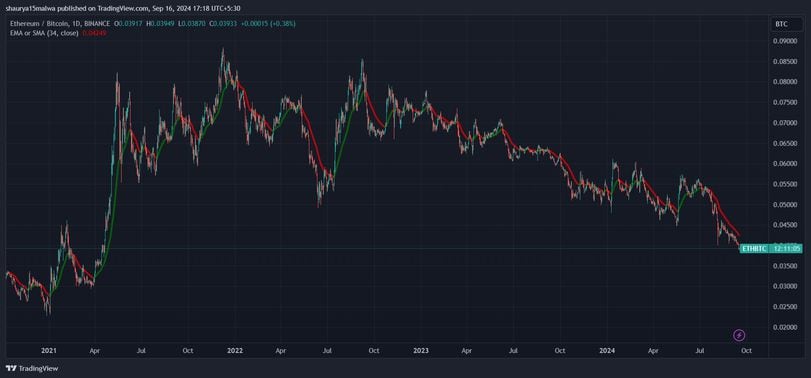News
Ether-Bitcoin Ratio Drops to Lowest Since April 2021. Here’s Why It Matters
-
The ETH/BTC ratio has hit its lowest since April 2021, dipping below 0.04, signaling a decline in investor interest in ether relative to bitcoin.
-
The preference has swung towards bitcoin, which was influenced by the introduction of bitcoin ETFs, which saw significant inflows compared to ether ETFs experiencing net outflows.
-
Some traders say this shift indicates a broader market favoring bitcoin's perceived stability over ether's riskier, high-yield potential.
-
Analysts suggest the ETH/BTC ratio might drop further, potentially to the 0.02-0.03 range, unless there's a significant change in investor sentiment or regulatory clarity that might favor riskier assets like altcoins.
A closely watched ratio tracking the relative price strength of ether (ETH) against bitcoin (BTC) has dropped to its lowest level since April 2021, indicative of a fallout in investor demand for the world’s second-largest token.
The ether-bitcoin trading pair fell under 0.04 late Sunday to trade at 0.039 in European morning hours Monday, extending year-to-date losses to nearly 30%. Although colloquially called a ratio - ETH/BTC is simply the trading pair of ether against bitcoin on crypto exchanges, which attracts hundreds of millions in daily volumes.
Over the past five years, the ETH/BTC ratio has risen from 0.02 to a peak of above 0.08 in early 2022 - meaning ETH had quadrupled in value relative to BTC at the time.
Its value proposition has been on the decline ever since - bitcoin set fresh lifetime highs in April in U.S. dollars (before tumbling 20%), while ether is yet to break its highs from 2021 and is down 52% from its 2021 peak. Year-to-date, bitcoin has returned over 40% to investors while ether holders have gained just under 1% .

A surge indicates that ether is outperforming bitcoin and vice-versa. During a rise, traders consider a preference for ETH as beneficial for riskier assets and Ethereum ecosystem bets. On the other hand, a slide indicates a preference for Bitcoin and blockchains other than Ethereum.
Some traders say that demand for ether relative to bitcoin peaked in 2023, following which spot exchange-traded funds (ETFs) moved the goalposts in BTC’s favor.
“The long-term reason for the rise has been the activity of Ethereum developers, both in relation to the blockchain itself and the growing ecosystem around it,” FxPro senior analyst Alex Kuptsikevich said in an email to CoinDesk. “However, by the end of 2023, the trend shifted in Bitcoin's favor as the prospect of exchange-traded ETFs gained prominence.”
“It is important to note that the launch of ETFs on Ethereum has neither attracted similar buying interest, resulting in net outflows, nor reversed this downward trend in ratio,” Kuptsikevich added.
Ether ETFs have recorded net outflows of $580 million since going live in late July. In comparison, bitcoin ETFs took on over $12 billion in their first two months , and have recorded over $17 billion in net inflows in just over eight months of trading.
Technical aspects and the promise of better yield on other blockchains also contributed to the lack of demand for ETH, some opine.
“ETH/BTC is reaching new lows as the yield from staking ETH continues to be uncompetitive at around or less than 3% APR while staking stablecoins or trading other ecosystem tokens like TON deliver high yields,” crypto market researcher Nick Ruck said in a message to CoinDesk.
“BTC has also held up well within its range as the bitcoin spot ETFs recorded their best day of inflows in the last two weeks on Sept 13th, adding to its allure against ETH,” Ruck added.
Meanwhile, traders such as Kuptsikevich see further pain ahead for those betting on the ETH/BTC ratio.
“This ratio has the potential to fall further into the 0.02-0.03 range. This is surprising given the generally positive investor sentiment towards altcoins a few months after the BTC halving and the generally higher beta of altcoins to the stock market, which has been quite strong in recent months,” he noted.
“Investors are likely waiting for more clarity on the future monetary and regulatory regime. Only a sustained rally will encourage investors to seek higher returns and take more risks by buying altcoins,” Kuptsikevich concluded.

